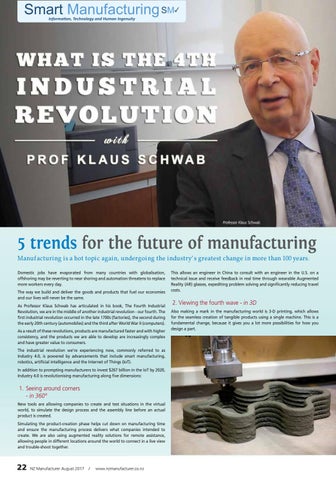The shortest way to do many things is to do only one thing at once. -Samuel Smiles
Professor Klaus Schwab.
5 trends for the future of manufacturing Manufacturing is a hot topic again, undergoing the industry’s greatest change in more than 100 years. Domestic jobs have evaporated from many countries with globalisation, offshoring may be reverting to near shoring and automation threatens to replace more workers every day. The way we build and deliver the goods and products that fuel our economies and our lives will never be the same. As Professor Klaus Schwab has articulated in his book, The Fourth Industrial Revolution, we are in the middle of another industrial revolution - our fourth. The first industrial revolution occurred in the late 1700s (factories), the second during the early 20th century (automobiles) and the third after World War II (computers). As a result of these revolutions, products are manufactured faster and with higher consistency, and the products we are able to develop are increasingly complex and have greater value to consumers. The industrial revolution we’re experiencing now, commonly referred to as Industry 4.0, is powered by advancements that include smart manufacturing, robotics, artificial intelligence and the Internet of Things (IoT). In addition to prompting manufacturers to invest $267 billion in the IoT by 2020, Industry 4.0 is revolutionising manufacturing along five dimensions:
1. Seeing around corners - in 360° New tools are allowing companies to create and test situations in the virtual world, to simulate the design process and the assembly line before an actual product is created. Simulating the product-creation phase helps cut down on manufacturing time and ensure the manufacturing process delivers what companies intended to create. We are also using augmented reality solutions for remote assistance, allowing people in different locations around the world to connect in a live view and trouble-shoot together.
22
NZ Manufacturer August 2017
/
www.nzmanufacturer.co.nz
This allows an engineer in China to consult with an engineer in the U.S. on a technical issue and receive feedback in real time through wearable Augmented Reality (AR) glasses, expediting problem solving and significantly reducing travel costs.
2. Viewing the fourth wave - in 3D Also making a mark in the manufacturing world is 3-D printing, which allows for the seamless creation of tangible products using a single machine. This is a fundamental change, because it gives you a lot more possibilities for how you design a part.
